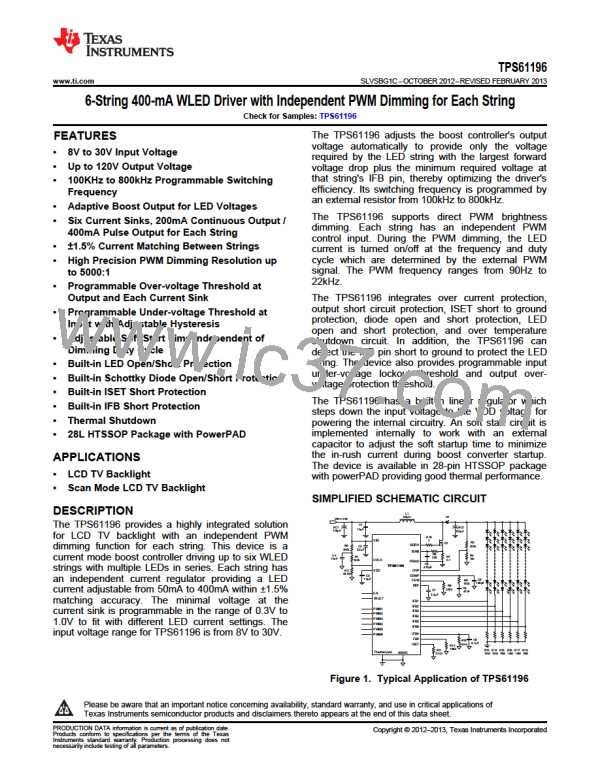TPS61196
www.ti.com
SLVSBG1C –OCTOBER 2012–REVISED FEBRUARY 2013
APPLICATION INFORMATION
Inductor Selection
The inductor is the most important component in switching power regulator design because it affects power
supply steady state operation, transient behavior, and loop stability. The inductor value, dc resistance and
saturation current are important specifications to be considered for better performance. Although the boost power
stage can be designed to operate in discontinuous mode at maximum load, where the inductor current ramps
down to zero during each switching cycle, most applications will be more efficient if the power stage operates in
continuous conduction mode, where a DC current flows through the inductor. Therefore, the Equation 8 and
Equation 9 below are for CCM operation only. The TPS61196 is designed to work with inductor values between
10 µH and 100 µH, depending on the switching frequency. Running the controller at higher switching frequencies
allows the use of smaller and/or lower profile inductors in the 10µH range. Running the controller at slower
switching frequencies requires the use of larger inductors, near 100µH, to maintain the same inductor current
ripple but may improve overall efficiency due to smaller switching losses. Inductor values can have ±20%
tolerance with no current bias. When the inductor current approaches saturation level, its inductance can
decrease 20% to 35% from the 0A value depending on how the inductor vendor defines saturation.
In a boost regulator, the inductor DC current can be calculated with Equation 7.
VOUT ´ IOUT
IL(DC)
=
V
´ η
IN
(7)
Where:
VOUT = boost output voltage
IOUT = boost output current
VIN = boost input voltage
η = power conversion efficiency, use 95% for TPS61196 applications
The inductor current peak-to-peak ripple can be calculated with Equation 8.
V ´ V
- V
IN
(
L ´ fSW ´ VOUT
)
IN
OUT
DIL(P-P)
=
(8)
Where:
ΔIL(P-P) = inductor ripple current
L = inductor value
fSW = switching frequency
VOUT = boost output voltage
VIN = boost input voltage
Therefore, the inductor peak current is calculated with Equation 9.
DIL(P-P)
IL(P) = IL(DC)
+
2
(9)
Select an inductor, which saturation current is higher than calculated peak current. To calculate the worst case
inductor peak current, use the minimum input voltage, maximum output voltage and maximum load current.
Regulator efficiency is dependent on the resistance of its high current path and switching losses associated with
the switch FET and power diode. Besides the external switch FET, the overall efficiency is also affected by the
inductor DC resistance (DCR). Usually the lower dc resistance shows higher efficiency. However, there is a trade
off between DCR and inductor footprint; furthermore, shielded inductors typically have higher DCR than
unshielded ones.
Schottky Diode
The TPS61196 demands a high-speed rectification for optimum efficiency. Ensure that the diode's average and
peak current rating exceed the output LED current and inductor peak current. In addition, the diode's reverse
breakdown voltage must exceed the application output voltage.
Copyright © 2012–2013, Texas Instruments Incorporated
Submit Documentation Feedback
19
Product Folder Links :TPS61196

 TI [ TEXAS INSTRUMENTS ]
TI [ TEXAS INSTRUMENTS ]